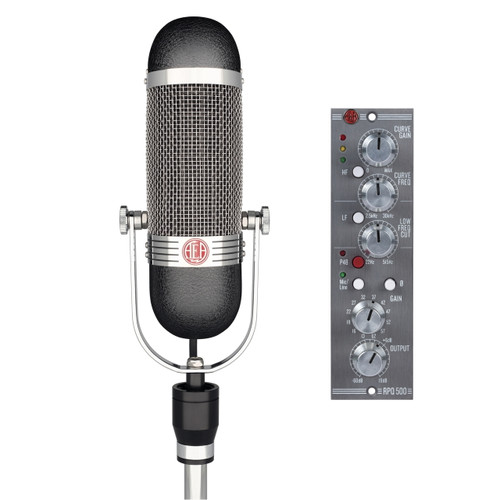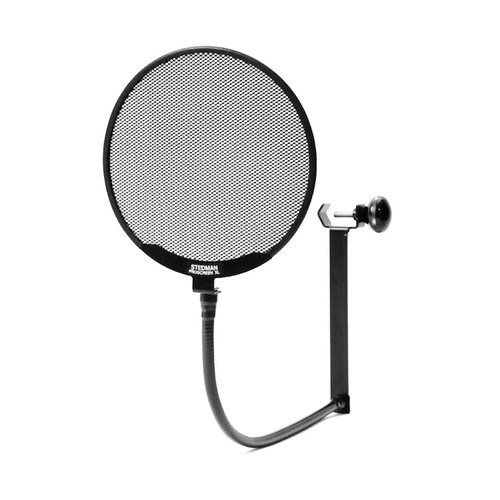The perfect mic and preamp bundle, with all the gain you could ever need for your lunchbox!
AEA R84 Details
The AEA R84 is an affordable Large Ribbon Geometry (LRG) microphone suitable for use by the most demanding audio professional or hobbyist.
If you are new to ribbons, you are in for a treat! Experienced users have discovered the R84 is an outstanding general-purpose microphone, ideally suited for solo and accent work. It is hard to find an application where this mic does not shine. It is a fine example of the natural sound and figure-8 directional sensitivity a quality ribbon mic delivers.
- Pure natural sound, just as you hear it when you're placing your mic in the studio.
- Quick smooth transients that capture the feeling of being there without sounding like a recording.
- Extended bass and treble that captures the details without shoving anything in your face.
- A figure-eight pattern that focuses your recording on the sound you want.
We believe you will enjoy the confidence this mic inspires. It's a forgiving tool that makes your recording work easier, as it literally sounds good on everything. Try it first and you'll usually like it and find it sits well in the mix. When time is scarce and quality necessary, put the R84 to the test. Our users' experience is that you'll use it more and more (in pairs too!). Then it will start to really grow on you.
Features
- Single-diaphragm with well-controlled,native figure-8 polar pattern
- Wide-band response from 20 Hz to 20 kHz
- High null-axis rejection and gain before feedback
- High SPL capability, 165 dB + above 1 kHz
- Effortless lows and smooth natural highs
- Fast, accurate transient reproduction
- Low self noise
- Excellent off-axis frequency response
Specifications
- Frequency Response: 20 Hz to 20 kHz
- Maximum SPL: 165 + dB SPL above 1 kHz for 1% third harmonic
- Output Sensitivity: -52 dBv/Pa
- Output Impedance: 270 Ω nominal
- Recommended Load: 1.2 kΩ or greater
- Powering: Not required or recommended
- Polarity: Pin 2 high for positive pressure on front of microphone.
- Connector: XLR-3M wired to a 3 m captive cable
Off Axis Response
- Polar Pattern: Native bi-directional pattern
- Horizontal: Level changes with angle, frequency response is consistent, –35 dB null at 90°/ 270°
- Vertical: Level changes with angle, reduced HF response above and below 0°/ 180° axis, –35 dB null at 90°/ 270°
Transducer element
- Ribbon Thickness: 1.8 μ (0.0000018 m) of pure aluminum
- Ribbon Width: 4.7 mm
- Ribbon Length: 59.7 mm
AEA RPQ500 Details
The RPQ500 module, designed after the successful RPQ preamp, provides the same ultra-clean, high-gain signal path that has earned AEA preamps their great reputation, but in a 500 series package. JFET circuit topology provides all the dynamics, subwoofer bass, and fast transients that your microphones can record. The NoLoad™ input impedance above 10K Ohms means the RPQ won’t load down a mic and change its sound. Low Energy Storage™ circuit design instantly recovers from overloads for superior dynamic performance. The original RPQ with CurveShaper™ was designed to fully capture every nuance of ribbon microphones: vintage or modern, passive or phantom powered. Engineers have discovered that the RPQ500 also complements their moving coil, condenser mics. By virtue of its sonic qualities and versatility, the VPR Alliance approved AEA RPQ500 is the tool of choice for all microphones whenever a true and pristine signal path is desired.
Features
- One channel with 81dB of sweet and quiet JFET gain for all mics
- High frequency CurveShaper™ EQ and low frequency proximity control
- Mic and line inputs for mixdown EQ versatility
- Switchable phantom power, polarity, line/mic, and EQ inserts
- NoLoad™ 10k Ohm high-impedance circuitry providing better overall transients, frequency response, and higher output sensitivity
Two Peas in a Pod: Musical Preamp, Sweet EQ
The CurveShaper’s™ high-frequency filter boost enables you to add a little extra “presence” or “air” to your source. The circuit functions similarly to a conventional parametric shelving boost, but with a significant difference: the slope varies as both the CurveShaper™ and HF Gain controls are adjusted. This unique bell curve was designed with the intention to compensate for the high-frequency roll-off that is inherent to most ribbon microphones. But beyond ribbon mics, the smooth HF filter is remarkably well suited for brightening up condenser mics used at a distance, restore presence in overly “dry” acoustical environments, or even as a clean and transparent air-band boost on the 2-bus.
The CurveShaper’s™ low-frequency control easily removes boxiness and boominess in a fast and unobtrusive way. Ribbon mics are capable of delivering strong subwoofer lows, and can have a significant bass proximity effect. Such strong low-frequency content can mask high-frequency intelligibility, so the tunable LF filter was engineered to tame low-frequency energy to appropriate levels. Its -20dB shelving curve is ideally suited to reduce excessive proximity effect, opening up new possibilities to use ribbon mics in close-up applications.
Specifications and Curves
- Gain at 1kHz: 81dB of gain at 1kHz, balanced-in to balanced-out in Microphone Input Mode
- Noise figure, rms A-weighted: < 2dB
- Noise figure, rms unweighted: < 3dB, 20 kHz LPF bandwidth
- EIN: < -130 dBu A-weighted, 150 Ohm resistive source
- Frequency response: -3dB < 1Hz and > 100 kHz
- THD: < 0.02% at 1 kHz
- Input impedance: 10K Ohms
- Balanced Line Input Impedance: 20K Ohms
- Input Gain control: Twelve-position switch provides from +13dB to +62dB of gain for the preamplifier circuit, as measured between the input and the before the output line driver.
- Switched LF Shelving filter: -3dB break-frequency tunable from 18 Hz to 360 Hz; maximum reduction -20dB.
- Switched CurveShape EQ: +3dB break-frequency tunable from 2.5 kHz to 30 kHz; HF gain adjustable from +0 dB to +18 dB; the slope of the HF filter varies interactively and directly with the CurveShaper™ frequency and gain settings
- Color LEDs: Green, Yellow, Red
- XLR output maximum level into 600Ω load: +28 dBu, balanced; 0 dBu = 0.7746 V rms
- XLR connectors polarity: Pin-1 is ground, pin-2 is high, pin-3 is low
- LED signal level indicators: Green snaps on at -6 dBu, red snaps on at +23 dBu, and yellow varies in brightness with level from -3 dBu to +20 dBu.
- External Features:
Laser engraved front panel markings
Grayhill series 71 stepped gain switch - Internal Operating Voltage: Bipolar 17V
- Size: 1.5” w, 6.8” d, 4.5” h (3.8cm x 17.27cm x 11.43cm)
- Weight: 11.7oz (~0.33 kg)














